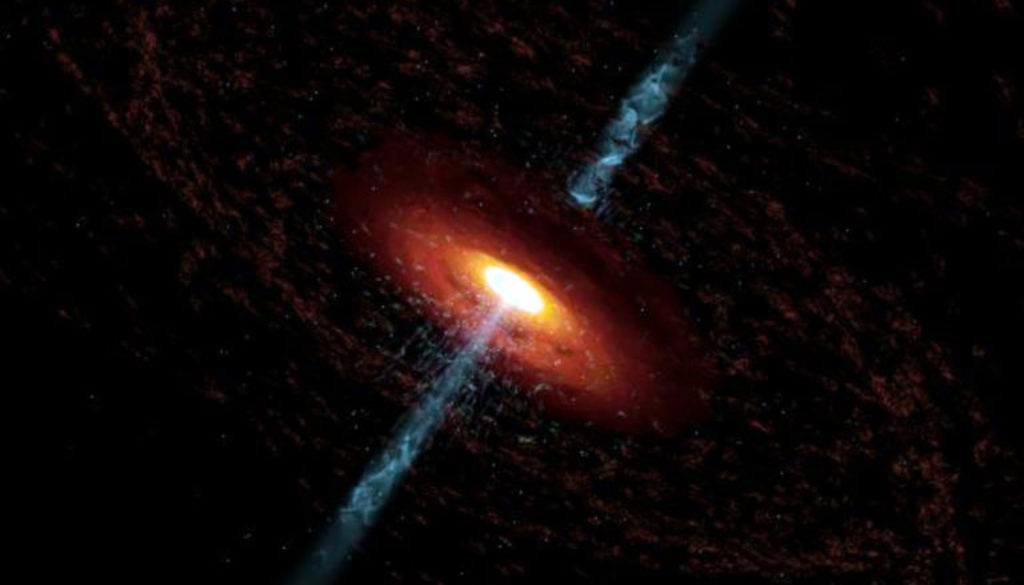Astronomers Capture Orbital Motion Around a Black Hole With Unprecedented Clarity

ALMA has made the most precise measurements of cold gas swirling around a supermassive black hole — the cosmic behemoth at the center of the giant elliptical galaxy NGC 3258. The multi-color ellipse reflects the motion of the gas orbiting the black hole, with blue indicating motion toward us and red motion away from us. The inset box represents how the orbital velocity changes with distance from the black hole. (Credit: ALMA (ESO/NAOJ/NRAO), B. Boizelle; NRAO/AUI/NSF, S. Dagnello; Hubble Space Telescope (NASA/ESA); Carnegie-Irvine Galaxy Survey.)
Images taken by NASA’s Hubble Space Telescope reveal a dusty disk at the center of NGC 3258 that is nearly 1,000 light-years across, making this galaxy a promising target for ALMA observations. As a part of his Ph.D. dissertation at the University of California, Irvine, Boizelle obtained ALMA CO observations of NGC 3258 in August 2017 that showed the gas is in nearly perfect rotation from the outer edge of the disk down to just 65 light-years from the supermassive black hole. By carefully modeling the gas rotation speed, he was able to measure the black hole’s mass with unprecedented precision. “Previous studies have demonstrated ALMA’s ability to detect rotating gas disks near a black hole and even to measure black hole masses in a few cases,” Boizelle said. “For the first time, however, these observations highly resolve cold gas rotation within what is called the sphere of influence — the innermost region of the galaxy where a black hole’s gravity is the dominant force.”

While ALMA observations have traced out cold gas rotation in dusty disks at the centers of other massive galaxies, Boizelle notes they do not frequently reveal rapid gas rotation within the sphere of influence. He describes NGC 3258 as an extraordinarily uncommon case and says that finding more examples like this one will help astronomers better understand the growth of black holes and galaxies over cosmic time.
The team’s paper, “A Precision Measurement of the Mass of the Black Hole in NGC 3258 From High-Resolution ALMA Observations of its Circumnuclear Disk,” can be viewed online along with related figures and captions and also via arXiv. For additional information about Boizelle, Walsh and astronomy at Texas A&M, visit http://mitchell.tamu.edu/research/Astronomy/. This story contains excerpts from a National Radio Astronomy Observatory brief authored by Public Information Officers Charles Blue and Suzy Gurton. # # # # # # # # # # About Research at Texas A&M University: As one of the world’s leading research institutions, Texas A&M is at the forefront in making significant contributions to scholarship and discovery, including that of science and technology. Research conducted at Texas A&M represented annual expenditures of more than $922 million in fiscal year 2018. Texas A&M ranked in the top 20 of the National Science Foundation’s Higher Education Research and Development survey (2017), based on expenditures of more than $905.4 million in fiscal year 2017. Texas A&M’s research creates new knowledge that provides basic, fundamental and applied contributions resulting, in many cases, in economic benefits to the state, nation and world. To learn more, visit http://research.tamu.edu/. -aTm- Contact: Shana K. Hutchins, (979) 862-1237 or shutchins@science.tamu.edu or Dr. Benjamin Boizelle, (979) 845-7778 or bboizelle@email.tamu.edu The post Astronomers Capture Orbital Motion Around a Black Hole With Unprecedented Clarity appeared first on College of Science.